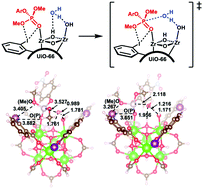Halogen bonding in UiO-66 frameworks promotes superior chemical warfare agent simulant degradation†
Abstract
Herein, a series of halogenated UiO-66 derivatives was synthesized and analyzed for the breakdown of the chemical warfare agent simulant dimethyl-4-nitrophenyl phosphate (DMNP) to analyze ligand effects. UiO-66-I degrades DMNP at a rate four times faster than the most active previously reported MOFs. MOF defects were quantified and ruled out as a cause for increased activity. Theoretical calculations suggest the enhanced activity of UiO-66-I originates from halogen bonding of the iodine atom to the phosphoester linkage allowing for more rapid hydrolysis of the P–O bond.

- This article is part of the themed collection: 1st International Conference on Noncovalent Interactions


 Please wait while we load your content...
Please wait while we load your content...
